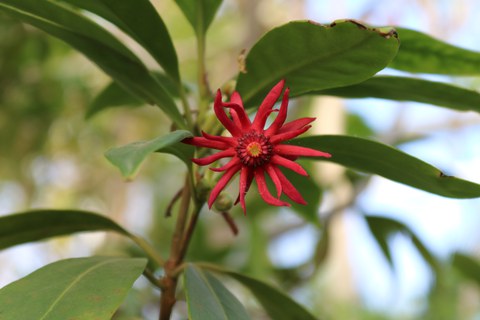Bisherige Pflanzen der Woche - Der Rote Sternanis
Der Rote Sternanis - Illicium floridanum J. ELLIS
Dort, wo im Mai die Riesenseerose Victoria amazonica (POEPP.) KLOTZSCH einziehen wird, warten derzeit die Kübelpflanzen auf den Frühling. Einige blühen jetzt im Winterquartier, darunter der Rote Sternanis Illicium floridanum.
Das immergrüne, bis 4 m hohe Gehölz wird auch als Amerikanischer Sternanis bezeichnet: Seine Heimat liegt in Nordost-Mexiko und den Küstenebenen von Louisiana bis Florida. Dort wächst er an Flussufern, in Sumpfgebieten und feuchten Wäldern. Seine aromatischen Blätter und Zweige enthalten unter anderem ätherische Öle und charakteristische, von Sesquiterpenen abgeleitete Inhaltsstoffe. Dieser chemische Cocktail hält die Pflanzen frei von Schädlingen.
Die bis zu 5 cm großen Blüten besitzen zwischen 21 und 33 lanzettliche, tief dunkelrote Blütenblätter. Eine Vielzahl kleiner Insekten, insbesondere Fliegen und Mücken, nutzt den in geringer Menge gebildeten Nektar als Futterquelle und überträgt dabei Pollenkörner. Da der Aktionsradius dieser Tiere sehr begrenzt ist, aber nur der Blütenstaub einer Zweitpflanze (Fremdpollen) zur Samenbildung führt, fällt der Fruchtansatz meist gering aus. Wenn die Befruchtung erfolgreich war, entstehen sternförmige Sammelbalgfrüchte, die bei Reife aufspringen und die blassbraunen Samen herausschleudern. Ergänzend zur sexuellen Fortpflanzung vermehrt sich die Pflanze über Wurzelschosse.
Die bekannteste der 40 Sternanis-Arten ist wohl Illicium verum HOOK. f.: Der aus Südost-China stammende Echte Sternanis wird in der dortigen Küche hochgeschätzt. Aus seinen Früchten sowie Gewürznelken, Cassia-Zimt, Fenchelsamen und Szechuanpfeffer besteht die bekannte „Fünf-Gewürze-Mischung“. Hierzulande dient Echter Sternanis zum Würzen von Backwaren, Pflaumenmus, Likör und Glühwein sowie als Aroma in der Parfümerie. Er zählt nicht zum Pflanzenbestand des Botanischen Gartens. Stattdessen finden Besucherinnen und Besucher unter den Kübelpflanzen eine andere chinesische Art der Gattung: Illicium henryi DIELS. Seine Knospen werden sich bald zu etwa 2 cm großen, schalenförmigen, blassroten, hängenden Blüten öffnen.
(KW 11/25)
Etwa 10.000 Pflanzenarten wachsen im Botanischen Garten der TU Dresden. Auf dieser Seite stellen wir Ihnen regelmäßig ein Beispiel aus dieser Vielfalt näher vor. Die Besonderheiten unserer wissenschaftlichen Pflanzensammlung zeigen sich auf vielerlei Art und Weise: in erstaunlichen Anpassungen, wunderlichen Namen, einer interessanten Verwendung oder auch in einer außergewöhnlichen Blütenpracht.
Die bisherigen Beiträge zur Pflanze der Woche können Sie im Archiv einsehen.

